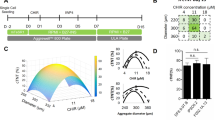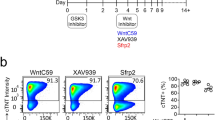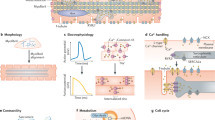Abstract
Existing methods for human induced pluripotent stem cell (hiPSC) cardiac differentiation are efficient but require complex, undefined medium constituents that hinder further elucidation of the molecular mechanisms of cardiomyogenesis. Using hiPSCs derived under chemically defined conditions on synthetic matrices, we systematically developed an optimized cardiac differentiation strategy, using a chemically defined medium consisting of just three components: the basal medium RPMI 1640, L-ascorbic acid 2-phosphate and rice-derived recombinant human albumin. Along with small molecule–based induction of differentiation, this protocol produced contractile sheets of up to 95% TNNT2+ cardiomyocytes at a yield of up to 100 cardiomyocytes for every input pluripotent cell and was effective in 11 hiPSC lines tested. This chemically defined platform for cardiac specification of hiPSCs will allow the elucidation of cardiomyocyte macromolecular and metabolic requirements and will provide a minimal system for the study of maturation and subtype specification.
This is a preview of subscription content, access via your institution
Access options
Subscribe to this journal
Receive 12 print issues and online access
$259.00 per year
only $21.58 per issue
Buy this article
- Purchase on Springer Link
- Instant access to full article PDF
Prices may be subject to local taxes which are calculated during checkout




Similar content being viewed by others
References
Matsa, E., Burridge, P.W. & Wu, J.C. Human stem cells for modeling heart disease and for drug discovery. Sci. Transl. Med. 239, 239ps6–(2014).
Burridge, P.W. et al. A universal system for highly efficient cardiac differentiation of human induced pluripotent stem cells that eliminates interline variability. PLoS One 6, e18293 (2011).
Kattman, S.J. et al. Stage-specific optimization of activin/nodal and BMP signaling promotes cardiac differentiation of mouse and human pluripotent stem cell lines. Cell Stem Cell 8, 228–240 (2011).
Burridge, P.W., Keller, G., Gold, J.D. & Wu, J.C. Production of de novo cardiomyocytes: human pluripotent stem cell differentiation and direct reprogramming. Cell Stem Cell 10, 16–28 (2012).
Zhang, J. et al. Extracellular matrix promotes highly efficient cardiac differentiation of human pluripotent stem cells: the matrix sandwich method. Circ. Res. 111, 1125–1136 (2012).
Lian, X. et al. Robust cardiomyocyte differentiation from human pluripotent stem cells via temporal modulation of canonical Wnt signaling. Proc. Natl. Acad. Sci. USA 109, E1848–E1857 (2012).
Burridge, P.W. et al. Improved human embryonic stem cell embryoid body homogeneity and cardiomyocyte differentiation from a novel V-96 plate aggregation system highlights interline variability. Stem Cells 25, 929–938 (2007).
Yang, L. et al. Human cardiovascular progenitor cells develop from a KDR+ embryonic-stem-cell-derived population. Nature 453, 524–528 (2008).
Elliott, D.A. et al. NKX2–5(eGFP/w) hESCs for isolation of human cardiac progenitors and cardiomyocytes. Nat. Methods 8, 1037–1040 (2011).
Laflamme, M.A. et al. Cardiomyocytes derived from human embryonic stem cells in pro-survival factors enhance function of infarcted rat hearts. Nat. Biotechnol. 25, 1015–1024 (2007).
Willems, E. et al. Small molecule-mediated TGF-beta type II receptor degradation promotes cardiomyogenesis in embryonic stem cells. Cell Stem Cell 11, 242–252 (2012).
Titmarsh, D.M. et al. Microbioreactor arrays for full factorial screening of exogenous and paracrine factors in human embryonic stem cell differentiation. PLoS One 7, e52405 (2012).
Moore, G.E., Gerner, R.E. & Franklin, H.A. Culture of normal human leukocytes. J. Am. Med. Assoc. 199, 519–524 (1967).
Brewer, G.J. & Cotman, C.W. Survival and growth of hippocampal neurons in defined medium at low density: advantages of a sandwich culture technique or low oxygen. Brain Res. 494, 65–74 (1989).
Uosaki, H. et al. Efficient and scalable purification of cardiomyocytes from human embryonic and induced pluripotent stem cells by VCAM1 surface expression. PLoS One 6, e23657 (2011).
Carpenter, L. et al. Efficient differentiation of human induced pluripotent stem cells generates cardiac cells that provide protection following myocardial infarction in the rat. Stem Cells Dev. 21, 977–986 (2012).
Graichen, R. et al. Enhanced cardiomyogenesis of human embryonic stem cells by a small molecular inhibitor of p38 MAPK. Differentiation 76, 357–370 (2008).
Melkoumian, Z. et al. Synthetic peptide-acrylate surfaces for long-term self-renewal and cardiomyocyte differentiation of human embryonic stem cells. Nat. Biotechnol. 28, 606–610 (2010).
Nagaoka, M., Si-Tayeb, K., Akaike, T. & Duncan, S.A. Culture of human pluripotent stem cells using completely defined conditions on a recombinant E-cadherin substratum. BMC Dev. Biol. 10, 60 (2010).
Braam, S.R. et al. Recombinant vitronectin is a functionally defined substrate that supports human embryonic stem cell self-renewal via alphavbeta5 integrin. Stem Cells 26, 2257–2265 (2008).
Rodin, S. et al. Clonal culturing of human embryonic stem cells on laminin-521/E-cadherin matrix in defined and xeno-free environment. Nat. Commun. 5, 3195 (2014).
Rodin, S. et al. Long-term self-renewal of human pluripotent stem cells on human recombinant laminin-511. Nat. Biotechnol. 28, 611–615 (2010).
Miyazaki, T. et al. Laminin E8 fragments support efficient adhesion and expansion of dissociated human pluripotent stem cells. Nat. Commun. 3, 1236 (2012).
Domogatskaya, A., Rodin, S. & Tryggvason, K. Functional diversity of laminins. Annu. Rev. Cell Dev. Biol. 28, 523–553 (2012).
Tohyama, S. et al. Distinct metabolic flow enables large-scale purification of mouse and human pluripotent stem cell-derived cardiomyocytes. Cell Stem Cell 12, 127–137 (2013).
Paige, S.L. et al. Endogenous Wnt/beta-catenin signaling is required for cardiac differentiation in human embryonic stem cells. PLoS One 5, e11134 (2010).
Martin, A.F. Turnover of cardiac troponin subunits. Kinetic evidence for a precursor pool of troponin-I. J. Biol. Chem. 256, 964–968 (1981).
Ng, S.Y., Wong, C.K. & Tsang, S.Y. Differential gene expressions in atrial and ventricular myocytes: insights into the road of applying embryonic stem cell-derived cardiomyocytes for future therapies. Am. J. Physiol. Cell Physiol. 299, C1234–C1249 (2010).
Minami, I. et al. A small molecule that promotes cardiac differentiation of human pluripotent stem cells under defined, cytokine- and xeno-free conditions. Cell Reports 2, 1448–1460 (2012).
Chuva de Sousa Lopes, S.M. et al. Patterning the heart, a template for human cardiomyocyte development. Dev. Dyn. 235, 1994–2002 (2006).
Bird, S.D. et al. The human adult cardiomyocyte phenotype. Cardiovasc. Res. 58, 423–434 (2003).
Xie, C., Lin, Z., Hanson, L., Cui, Y. & Cui, B. Intracellular recording of action potentials by nanopillar electroporation. Nat. Nanotechnol. 7, 185–190 (2012).
Francis, G.L. Albumin and mammalian cell culture: implications for biotechnology applications. Cytotechnology 62, 1–16 (2010).
Takahashi, T. et al. Ascorbic acid enhances differentiation of embryonic stem cells into cardiac myocytes. Circulation 107, 1912–1916 (2003).
Cao, N. et al. Ascorbic acid enhances the cardiac differentiation of induced pluripotent stem cells through promoting the proliferation of cardiac progenitor cells. Cell Res. 22, 219–236 (2012).
Blaschke, K. et al. Vitamin C induces Tet-dependent DNA demethylation and a blastocyst-like state in ES cells. Nature 500, 222–226 (2013).
Moyes, K.W. et al. Human embryonic stem cell-derived cardiomyocytes migrate in response to gradients of fibronectin and Wnt5a. Stem Cells Dev. 22, 2315–2325 (2013).
Tribulova, N. et al. Enhanced connexin-43 and alpha-sarcomeric actin expression in cultured heart myocytes exposed to triiodo-L-thyronine. J. Mol. Histol. 35, 463–470 (2004).
Wang, B., Ouyang, J. & Xia, Z. Effects of triiodo-thyronine on angiotensin-induced cardiomyocyte hypertrophy: reversal of increased beta-myosin heavy chain gene expression. Can. J. Physiol. Pharmacol. 84, 935–941 (2006).
Zhang, Q. et al. Direct differentiation of atrial and ventricular myocytes from human embryonic stem cells by alternating retinoid signals. Cell Res. 21, 579–587 (2011).
Chen, G. et al. Chemically defined conditions for human iPSC derivation and culture. Nat. Methods 8, 424–429 (2011).
Yap, L.Y. et al. Defining a threshold surface density of vitronectin for the stable expansion of human embryonic stem cells. Tissue Eng. Part C Methods 17, 193–207 (2011).
Fusaki, N., Ban, H., Nishiyama, A., Saeki, K. & Hasegawa, M. Efficient induction of transgene-free human pluripotent stem cells using a vector based on Sendai virus, an RNA virus that does not integrate into the host genome. Proc. Jpn. Acad., Ser. B, Phys. Biol. Sci. 85, 348–362 (2009).
Mali, P. et al. Butyrate greatly enhances derivation of human induced pluripotent stem cells by promoting epigenetic remodeling and the expression of pluripotency-associated genes. Stem Cells 28, 713–720 (2010).
Okita, K. et al. A more efficient method to generate integration-free human iPS cells. Nat. Methods 8, 409–412 (2011).
Chou, B.K. et al. Efficient human iPS cell derivation by a non-integrating plasmid from blood cells with unique epigenetic and gene expression signatures. Cell Res. 21, 518–529 (2011).
Thomson, J.A. et al. Embryonic stem cell lines derived from human blastocysts. Science 282, 1145–1147 (1998).
Ng, E.S., Davis, R., Stanley, E.G. & Elefanty, A.G. A protocol describing the use of a recombinant protein-based, animal product-free medium (APEL) for human embryonic stem cell differentiation as spin embryoid bodies. Nat. Protoc. 3, 768–776 (2008).
Lin, Z.C., Xie, C., Osakada, Y., Cui, Y. & Cui, B. Iridium oxide nanotube electrodes for sensitive and prolonged intracellular measurement of action potentials. Nat. Commun. 5, 3206 (2014).
Acknowledgements
We thank J. Odegaard for analysis of teratoma slides, and K.R. Boheler and R.L. Gundry for their insightful comments on this manuscript. This work was supported by the American Heart Association Postdoctoral Fellowship grant 12POST12050254, Beginning Grant-in-Aid 14BGIA20480329 and US National Institutes of Health K99 HL121177 to P.W.B., and American Heart Association Established Investigator Award 14420025, Foundation Leducq, the National Institutes of Health U01 HL099776, R01 HL113006 and R24 HL117756, and the California Institute for Regenerative Medicine TR3-05556 and DR2-05394 to J.C.W.
Author information
Authors and Affiliations
Contributions
P.W.B. conceived, performed and interpreted the experiments and wrote the manuscript; E.M. performed cardiomyocyte immunofluorescence, single-cell RT-PCR and electrophysiology data assessment; P.S., Z.C.L. and O.J.A. performed electrophysiology experiments and assessed data; S.D. provided 'CoMiP' reprogrammed cells; B.H. performed the teratoma assay; J.M.C., A.D.E., F.L., N.M.M. and J.R.P. tested differentiation; B.C. and J.D.G. provided experimental advice; and J.C.W. provided experimental advice, wrote the manuscript and provided funding support.
Corresponding authors
Ethics declarations
Competing interests
J.C.W. is a co-founder of Stem Cell Theranostics.
Supplementary information
Supplementary Text and Figures
Supplementary Figures 1–12 and Supplementary Tables 1–6 (PDF 12731 kb)
Supplementary Video 1
hiPSCs differentiated using CDM3 at day 9, matches Supplementary Figure 5. (MOV 3610 kb)
Supplementary Video 2
hiPSCs differentiated using CDM3 at day 10, matches Supplementary Figure 5. (MOV 4735 kb)
Supplementary Video 3
hiPSCs differentiated using CDM3 at day 11 matches Supplementary Figure 5. (MOV 4862 kb)
Supplementary Video 4
hiPSCs differentiated using CDM3 on growth factor-reduced Matrigel at day 22, matches Supplementary Figure 6d. (MOV 4477 kb)
Supplementary Video 5
hiPSCs differentiated using CDM3 on recombinant human E-cadherin at day 22, matches Supplementary Figure 6d. (MOV 2295 kb)
Supplementary Video 6
hiPSCs differentiated using CDM3 on recombinant human vitronectin at day 22, matches Supplementary Figure 6d. (MOV 2370 kb)
Supplementary Video 7
hiPSCs differentiated using CDM3 on vitronectin peptide at day 22, matches Supplementary Figure 6d. (MOV 3787 kb)
Supplementary Video 8
hiPSCs differentiated using CDM3 on recombinant human laminin-521 at day 22, matches Supplementary Figure 6d. (MOV 3920 kb)
Supplementary Video 9
hiPSCs differentiated using CDM3 on truncated recombinant human laminin-511 at day 22, matches Supplementary Figure 6d. (MOV 2066 kb)
Rights and permissions
About this article
Cite this article
Burridge, P., Matsa, E., Shukla, P. et al. Chemically defined generation of human cardiomyocytes. Nat Methods 11, 855–860 (2014). https://doi.org/10.1038/nmeth.2999
Received:
Accepted:
Published:
Issue Date:
DOI: https://doi.org/10.1038/nmeth.2999
This article is cited by
-
Switching of hypertrophic signalling towards enhanced cardiomyocyte identity and maturity by a GATA4-targeted compound
Stem Cell Research & Therapy (2024)
-
HAND factors regulate cardiac lineage commitment and differentiation from human pluripotent stem cells
Stem Cell Research & Therapy (2024)
-
α-Melanocyte-stimulating hormone alleviates pathological cardiac remodeling via melanocortin 5 receptor
EMBO Reports (2024)
-
In situ monolayer patch clamp of acutely stimulated human iPSC-derived cardiomyocytes promotes consistent electrophysiological responses to SK channel inhibition
Scientific Reports (2024)
-
Ghrelin mediated cardioprotection using in vitro models of oxidative stress
Gene Therapy (2024)



